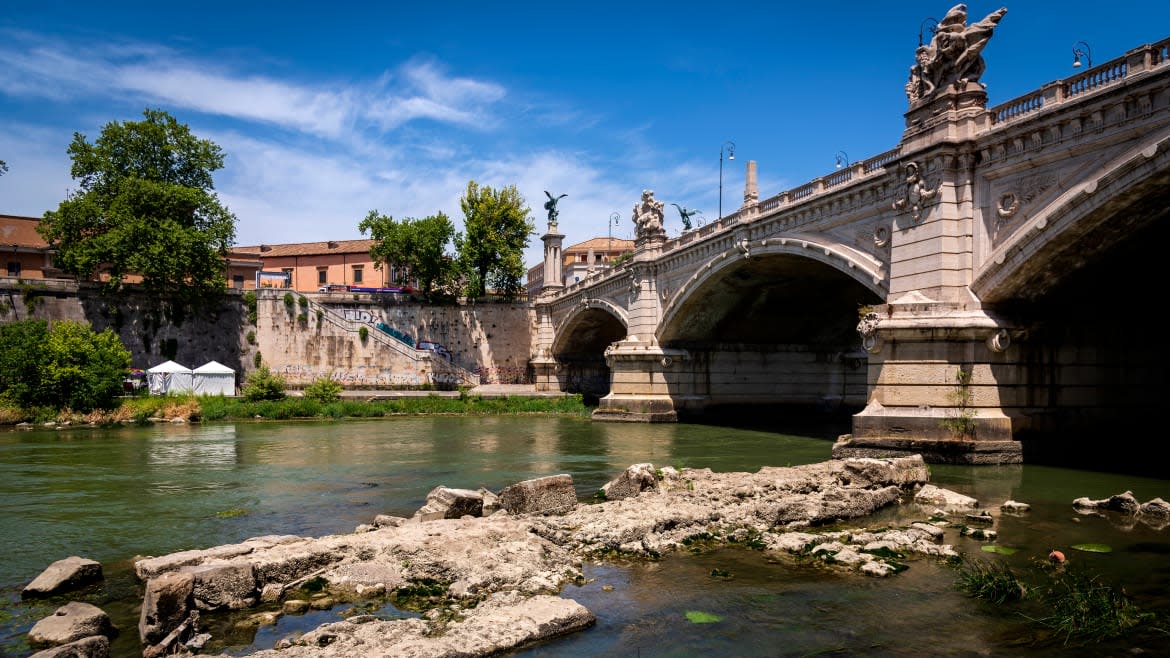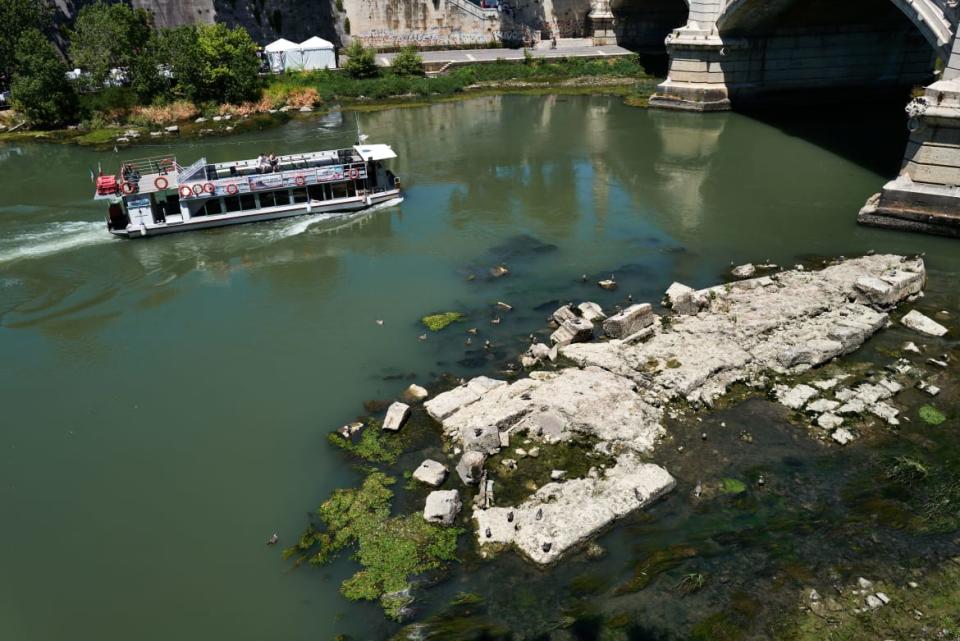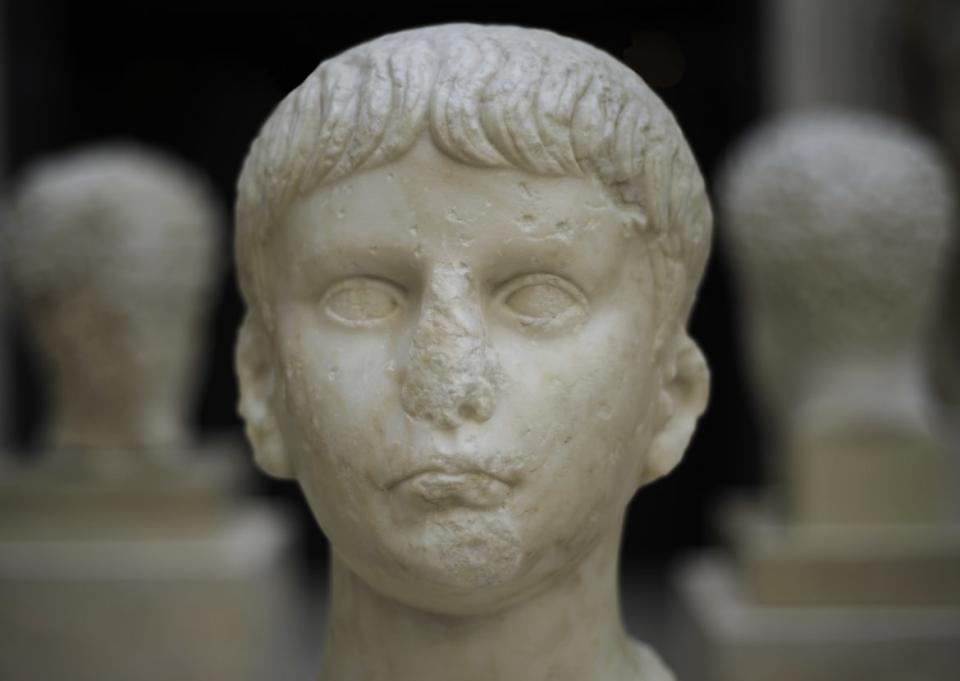Nero’s Bridge Suddenly Appears, Reminding Us Some Thought He Never Died

- Oops!Something went wrong.Please try again later.
- Oops!Something went wrong.Please try again later.
This month, as a direct result of the heat wave and water shortages across much of Europe, an ancient bridge reappeared in the Tiber in Rome. The structure, which was supposedly built by Emperor Nero in the first century, has attracted criticism and some mockery for its poor construction and design. Perhaps the more interesting story though, is the ways in which the bridge’s sudden reappearance manifests something characteristic of Nero himself. His legend and legacy refuse to die.
The bridge, also known as the Pons Neronianus, emerged out of the water because of the record low water levels in the Tiber caused by drought. Many news reports have stressed that the location of the bridge was poorly chosen. Dr. Rabun Taylor, a classics professor at the University of Texas at Austin, told Live Science that it was built “on a tight bend in a floodplain.” Taylor further explained that, “River bends cutting through pure sediment tend to wander and change shape, so their banks are prone to losing contact with [the] bridge abutments” that connect the bridge with the ground.
It’s not at all clear, however, that the site for the bridge was selected by Nero. A number of scholars have suggested that the bridge was constructed before the reign of Nero and that the Neronian bridge was just a refortification and reconstruction of this earlier crossing. If this is the case, it seems unfair to blame Nero for the location.
It is true, however, that Nero was interested in building projects in Rome. Though many historians and some of his contemporaries have criticized him for his excessive spending and lavish interior design, his work influenced architecture throughout the city. His primary project, the Domus Aurea (Golden House), was known for its extensive use of gold leaf, bejeweled walls and ceilings, glassy floors, and monumental gardens (complete with an artificial lake, streams, and trees). Suetonius’ biography of Nero describes it as: “overlaid with gold and adorned with gems and mother-of-pearl. There were dining-rooms with fretted ceilings of ivory, whose panels could turn and shower down flowers and were fitted with pipes for sprinkling the guests with perfumes. The main banquet hall was circular and constantly revolved day and night, like the heavens” (Nero 31.1-2).

A tourist river boat sails near the Vittorio Emanuele II bridge in Rome as the low water level of the river Tiber reveals an ancient bridge built during the rule of Roman Emperor Nero.
This kind of decadence was matched by what can only generously be described as his patronage of the arts. Another way to put it would be to say that Nero was a party animal. He became emperor at the tender ago of 16, and had a passion for music, theater, and chariot racing. He started off well with a speech to the Senate in which he promised to drain the proverbial swamp and return power to the Roman Senate. He initially seemed to follow through: he gave money to every citizen, introduced a salary for senators, gave free grain to the Praetorian Guard (his bodyguards), constructed a market, won military victories and threw awe-inspiring games.
Over time, however, things went south. He ordered the murder of his mother, who had formerly been his chief adviser; had his ex-wife Octavia brutally murdered; allegedly kicked his pregnant second wife Poppaea to death in a fit of rage; and is said to have married a boy named Sporus. The likely enslaved Sporus apparently resembled Poppaea, whom Nero regretted killing. According to Suetonius, Nero had him castrated and married him in a traditional wedding ceremony complete with a veil and dowry. After that, Sporus appeared in public in the regalia of an empress and was allegedly addressed as “empress,” “lady,” or even “Poppaea.” (These weren’t the only instances of sexual violence associated with Nero: Suetonius also notes that he raped a vestal virgin and committed incest with his mother—pre-mortem).
In A.D. 68, one of the governors of what is now France rebelled in response to Nero’s tax policies. While his rebellion was crushed it triggered a more widespread sense of dissatisfaction and unease among the ruling class. Galba, the governor of part of modern Spain, also rebelled and, despite being declared a public enemy, won the support of Nero’s bodyguards. With his military support turned against him, Nero knew he was in trouble. He toyed with the idea of raising troops from some of the Eastern Provinces or throwing himself at Galba’s mercy, but in the end he fled to the villa of one of his imperial freedmen with a cluster of loyal freedmen (including Sporus) in tow. Nero ordered them to dig a grave for him. He couldn’t quite summon up the courage to kill himself so, in the end, he tasked his former secretary, Epaphroditus, with helping him. He was 30 years old.

Bust of Nero as a child.
To say that Nero was famous in antiquity would be to understate things, but there is some confusion about who celebrated his death. The sources that describe him as a tyrant were written sometime later, with an ungenerous spirit. Suetonius claimed that everyone in Rome delighted in the news of his suicide, but Tacitus notes that lower status inhabitants were upset. According to Philostratus, those in the Eastern provinces mourned Nero.
Like others, Nero was the victim of a damnatio memoriae, a process in which the memory of a person (usually an emperor but sometimes also other important people) was erased through the defacing of monuments and coins. The problem with this process, as Princeton classicist Harriet Flower has written, is that it just doesn’t work. Excisions leave a mark that only draws more attention to what was once there. Erasure was especially ineffective in the case of Nero: The man who could not be controlled in life could not be controlled in death either.
As Shushma Malik, a soon to be Assistant Professor of Classics at the University of Cambridge and Onassis Classics Fellow at Newnham College, Cambridge, told me: “He had a public funeral and was buried in his family’s mausoleum on the Pincian Hill.” That should have been that, said Malik, “but there’s a twist.” In the years following his death, “two or perhaps three separate imposters appeared in the east claiming to be Nero—the rightful emperor who had not died as people thought, but had instead fled from Rome. Using his name, the imposters collected supporters with a view to reclaiming the Roman ‘throne’. On all occasions, these false Neros were unsuccessful.” But their facility in music and vague similarity to Nero rallied people to their cause and stoked the fires of a tradition that Nero would one day return.
One of the reasons for the emergence of these rumors, said Malik, is that Nero’s death had triggered a civil war also known as the Year of the Four Emperors (A.D. 69). During this turbulent period Galba, Otho, Vitellius, and Vespasian all vied for imperial power, but Vespasian emerged victorious and founded the Flavian dynasty. It seems, says Malik, that in the Eastern provinces, where people didn’t hear rumors about matricide and forcible castration, Nero was sincerely mourned. This wistfulness, Nero’s youth, and the private nature of his death created a space for rumors to flourish. She pointed to Dio Chrysostom, a first-century Greek-speaking Turk, who wrote “Indeed the truth about [Nero] has not come out even yet; for so far as the rest of his subjects were concerned, there was nothing to prevent his continuing to be Emperor for all time, seeing that even now everybody wishes he were still alive.” (Orations 21.9-10).
In her book, The Nero Anti-Christ Founding and Fashioning a Paradigm, Malik explores the long history of hopeful and condemnatory traditions about Nero. There were many who remembered him fondly. An oversized status from second-century Tralles (modern day Turkey), for example, demonstrated this well. It’s really two groups of people—second- and third-century Roman elites (like Tacitus, Suetonius, and Cassius Dio) and early Christians—who despised him. From the third century on, shows Malik, Christians began to explicitly associate Nero with the beast of Revelation and the eschatological Antichrist. The widespread belief that Nero might return, especially as an eschatological monster, persisted for centuries. As late as A.D. 422, St. Augustine of Hippo was referring to it.
But Nero’s story does not end here; he became a touchstone for a broad range of theological and cultural debates in the nineteenth century. Roughly 1,800 years after his death, Malik told me, Nero got “caught up in theological debates surrounding the rise of Anglo-Catholicism in Britain, which made Nero the perfect response to accusations from Protestants that the Pope was the Antichrist.” Others wanted to use Nero to highlight the problem with sectarian denominational divides. The Protestant Dean of Canterbury Cathedral, Frederick William Farrar, wrote a popular historical novel Darkness and Dawn, or Scenes from the Days of Nero, which had the partial agenda of reminding “people that Nero was the enemy of all Christians.”
While Christian clerics were using Nero to battle sectarianism, the Decadent aesthetes of the age saw him as an icon. The Decadent Movement was a cultural movement that celebrated excess, skepticism, artifice, perversion, cultural norms, and debauchery. To them Nero was an example of what they as artists could accomplish if given the unlimited resources and power of an emperor. They sensed a kindred spirit who teetered on the edge of social damnation. “Nero the artist was petulant, volatile, and difficult to control,” said Malik, “but he also sang, acted on stage, and played the lyre.” In an era of pushing boundaries “The fact that Nero could also be held up by some as the Antichrist” only made the Decadents’ admiration of him more scandalous and appealing.
Perhaps the most famous example of the Decadent idolization of Nero is Oscar Wilde. Though we usually picture him with a longer wavy hairstyle, in 1883 he cut it in imitation of Nero. According to Wilde, “I was in the gallery of the Louvre in Paris, and I saw the bust of a young Roman Emperor. It was very beautiful, indeed. As soon as I saw that the young Emperor had his hair cut short, I wanted to be like him.” Wilde claimed that it was only afterwards that he learned that the sculpture “represented Nero, one of the worst behaved young men in the world, and yet a man of strong artistic passion.” Courting controversy was Wilde’s brand and it certainly makes an otherwise unremarkable (some might say ugly) haircut provocative.
That an architectural memento of Nero has re-emerged from the waters of drought-plagued Rome seems in keeping with Nero’s general habit of popping up unexpectedly. They say that you cannot keep a good man down, but it turns out that you cannot keep a debauched artist submerged either.
Get the Daily Beast's biggest scoops and scandals delivered right to your inbox. Sign up now.
Stay informed and gain unlimited access to the Daily Beast's unmatched reporting. Subscribe now.

